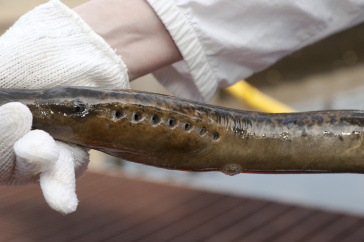UNH Researcher Receives $750,000 from NSF for Ongoing Work on Lamprey Hormones

Sea lamprey Credit: Mike Ross, UNH Photographic Services.
DURHAM, N.H. - University of New Hampshire professor of biochemistry Stacia Sower has received a prestigious Accomplishment-Based Renewal grant from the National Science Foundation. The grant, of $750,000 over five years, will support Sower's ongoing investigation into the reproductive hormones in the sea lamprey, one of the oldest lineages of vertebrates in the world. Accomplishment-Based Renewal (ABR) grants are among the NSF's most competitive; of the 11,524 grants from the NSF in 2012 only 30 were ABR grants. It is believed that Sower's represents the first to a UNH faculty member.
With the grant, Sower, who directs UNH's Center for Molecular and Comparative Endocrinology, will investigate the unique brain and pituitary glycoprotein hormones and receptors that regulate reproduction and metabolism in the sea lamprey. In existence millions of years before the age of dinosaurs, lampreys are studied as a model organism for the clues their brains and neuroendocrine systems hold to our earliest vertebrate ancestors.
"Results of this research will tell us whether these hormones share common functional and developmental features with the other hormones found in all other vertebrates," Sower says. "Gaining a better understanding of reproductive hormones will be critical for development of new strategies for improving and controlling reproduction, from fish to humans."
The Sower lab has discovered in the sea lamprey a unique pituitary glycoprotein hormone not found in any other vertebrate. This research leads to a new paradigm to be tested in how the pituitary controls reproduction and metabolism.
The NSF grant will fund research opportunities for undergraduate and graduate students as well as postdoctoral researchers and will facilitate ongoing collaborations between the CME and other researchers worldwide, among them 47 scientists who are annotating the lamprey genome. It will also support a range of outreach activities, including public talks, and has resulted in a new collaboration with Berta Levavi-Sivan of The Hebrew University of Jerusalem. Currently, one of Sower's graduate students, James Gargan, is in her laboratory for two months working on aspects of the research.
Sower, who has been on the UNH faculty for three decades and is a member of the department of molecular, cellular and biomedical sciences within the College of Life Sciences and Agriculture, has received continuous NSF support since 1986. She has published more than 170 journal articles and was a contributor to the recent sequencing of the sea lamprey genome, published in the journal Nature Genetics. This summer, she delivered the opening plenary talk at the International Congress of Comparative Endocrinology. Earlier this year, Sower was named a fellow of the American Association for the Advancement of Science. Mentoring and developing scientists has long been a focus of her career; in her lab at UNH she has trained 31 Ph.D. and M.S. graduate students, 71 undergraduates in projects and honors theses, and 11 postdoctoral fellow advisees.
The University of New Hampshire, founded in 1866, is a world-class public research university with the feel of a New England liberal arts college. A land, sea, and space-grant university, UNH is the state's flagship public institution, enrolling 12,200 undergraduate and 2,300 graduate students.
Photographs available to download:
/unhtoday/news/releases/2012/nov/sower.jpg
Stacia Sower, professor of biochemistry and director of the Center for Molecular and Comparative Endocrinology at the University of New Hampshire
Credit: Lisa Nugent, UNH Photographic Services.
/unhtoday/news/releases/2013/feb/lamprey.jpg
Sea lamprey
Credit: Mike Ross, UNH Photographic Services.
-30-
Latest News
-
October 30, 2024
-
October 10, 2024
-
October 8, 2024
-
October 3, 2024
-
October 1, 2024
















































